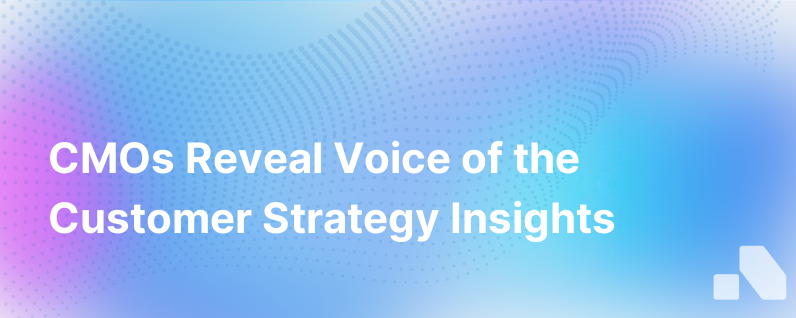Intake Is The Easy Part Cmos Discuss Voice Of The Customer Strategy
Published on December 26, 2023 by David Zhang
As Chief Marketing Officers (CMOs), we're often inundated with data pouring in from social media channels, customer support tickets, CRM systems, and market research. The intake of customer feedback is seldom the issue; the real challenge lies in transforming this voluminous data into actionable insights that can guide your company's customer experience strategy and product development. In modern business parlance, this process is known as the "Voice of the Customer" (VoC) strategy.
Implementing an effective VoC strategy is crucial for fostering customer-centricity within an organization and ultimately driving growth, but it is a nuanced and complex endeavor. In this deep dive, we will unravel what a Voice of the Customer strategy entails, its significance, pitfalls, and best practices as discussed by seasoned CMOs.
What is a Voice of the Customer Strategy?
A VoC strategy is a systematic approach to capturing customer feedback, expectations, preferences, and aversions across various touchpoints in the customer journey. It's designed to empower decision-makers with customer insights that influence every facet of the business operation, from product design to customer service.
The process extends far beyond mere data collection. It encompasses analysis, dissemination, and integration of customer insights into the business matrix. The ultimate goal is to align product offerings with customer needs, refine user experience, and adapt corporate strategies to meet market demands.
However, CMOs recognize that the real obstacle isn't data capture; it's what comes after. Herein lies the challenge: ensuring that customer voices are not just heard but also understood and acted upon.
Why Voice of the Customer Matters
In the digital age where customer expectations are high, and brand loyalty is fickle, VoC strategies provide a vital feedback loop to keep businesses grounded to their customers' evolving needs.
It demystifies customer behavior, expectations, and experiences, providing a roadmap for continuous improvement. A robust VoC program can lead to enhanced customer satisfaction, retention, and advocacy — all of which are cornerstones of sustained business success.
The Complexities of VoC and Best Practices
Many CMOs agree that while customer data intake can be streamlined through technology, the subsequent stages are fraught with complexities. Here are some best practices for navigating these challenges.
1. Prioritize and Segment Feedback It’s essential to prioritize and segment feedback based on its impact on customer satisfaction and business objectives. Not all feedback will require immediate action. Some might inform long-term strategy, while other insights might highlight areas for immediate improvement.
2. Connect Data Points for a Holistic View A common pitfall in VoC strategies is the siloed interpretation of feedback. Customer insights should be cross-referenced across multiple data points to create a comprehensive view of the customer experience. This might mean linking social media sentiment with support ticket trends or NPS scores with user behavior analytics.
3. Foster a Culture of Customer-Centricity VoC is not just a marketing initiative; it's an organizational mindset. Instilling a culture of customer-centricity ensures that customer insights permeate every aspect of the business. This involves training, encouraging inter-departmental collaboration, and establishing customer-focused metrics for performance evaluation.
4. Ensure Real-Time Responsiveness With the sheer velocity of customer feedback in the digital era, real-time responsiveness becomes paramount. Today’s customers expect quick fixes and swift communication around their feedback. Systems must be in place to monitor and respond to customer feedback as it surfaces.
5. Invest in Technology Wisely Utilizing the right technology stack can make VoC data more manageable and actionable. AI-powered tools can dissect large volumes of unstructured feedback, while analytics tools can spot trends that inform strategic decisions. However, it is crucial to choose solutions that integrate with existing systems and support the unique needs of your VoC strategy.
6. Balance Quantitative and Qualitative Data While quantitative data provides the metrics, qualitative feedback gives context. It's the stories behind the scores that often reveal the most actionable insights. Voice recordings, open-ended survey responses, and customer interviews can be gold mines for qualitative data.
7. Continuously Refine VoC Processes A VoC strategy is not set in stone. Regular audits of the data collection, analysis, and action implementation processes are necessary to ensure they remain relevant and effective.
VoC Strategy in Action
Effective VoC strategies strive for more than just capturing sentiment; they translate it into customer satisfaction and loyalty. For instance, a tech company might use VoC insights to identify pain points and streamline their software's user interface. A retailer might leverage customer service feedback to improve in-store training programs, while an online marketplace might adjust its recommendation algorithms based on purchase reviews.
Leveraging Technology to Enhance VoC
As technology advances, CMOs are considering platforms that not only automate the intake process but also distill and prioritize insights. Sophisticated AI platforms like Aomni sift through swathes of data, extracting valuable insights, and alerting to emerging customer concerns and opportunities in real-time, thus easing the considerable burden of "sense-making" from the deluge of customer feedback.
Conclusion
For CMOs continually seeking to establish dominance in fiercely competitive markets, a fully-realized Voice of the Customer strategy is the linchpin of customer-centric growth. While intake may be the easy part, it's the nuanced analysis, internal adoption, and actionable follow-through that differentiates a good strategy from a great one. With the right mix of prioritization, technology, culture, and adaptability, businesses can forge an indelible connection with their customers, one that transcends transactions and becomes a true conversation.